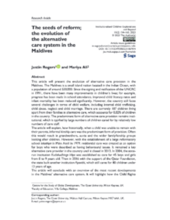Abstract:
This article will present the evolution of alternative care provision in the Maldives. The Maldives is a small island nation located in the Indian Ocean, with a population of around 530,000. Since the signing and ratification of the UNCRC in 1991, there have been many improvements in children’s lives; for example, progress has been made in school attendance, improved child literacy rates and infant mortality has been reduced significantly. However, the country still faces several challenges in terms of child welfare, including internal child trafficking, child abuse, neglect and child marriage. There are currently 187 children living apart from their families in alternative care, which accounts for 0.02% of children in the country.
The predominant form of alternative care provision remains insti-tutional, which is typified by large numbers of children cared for by relatively low numbers of care staff.The article will explain, how historically, when a child was unable to remain with their parents, informal kinship care was the predominant form of provision. Often this would result in grandmothers, aunts and the wider family/kinship groups looking after children. However, with the establishment of a large reformatory school Islaahiya in Male Atoll in 1979, residential care was created as an option for boys who were described as having behavioural issues.
It remained a key alternative care provider in the country until it closed in 2013. In 2004, the state-run institution Kudakudhinge Hiya was established to care for 45 boys and girls from 0 to 9 years old. Then in 2016 with the support of the Qatar Foundation, the state built another institution Fiyavithi, which still cares for 80 children under 13 years of age

